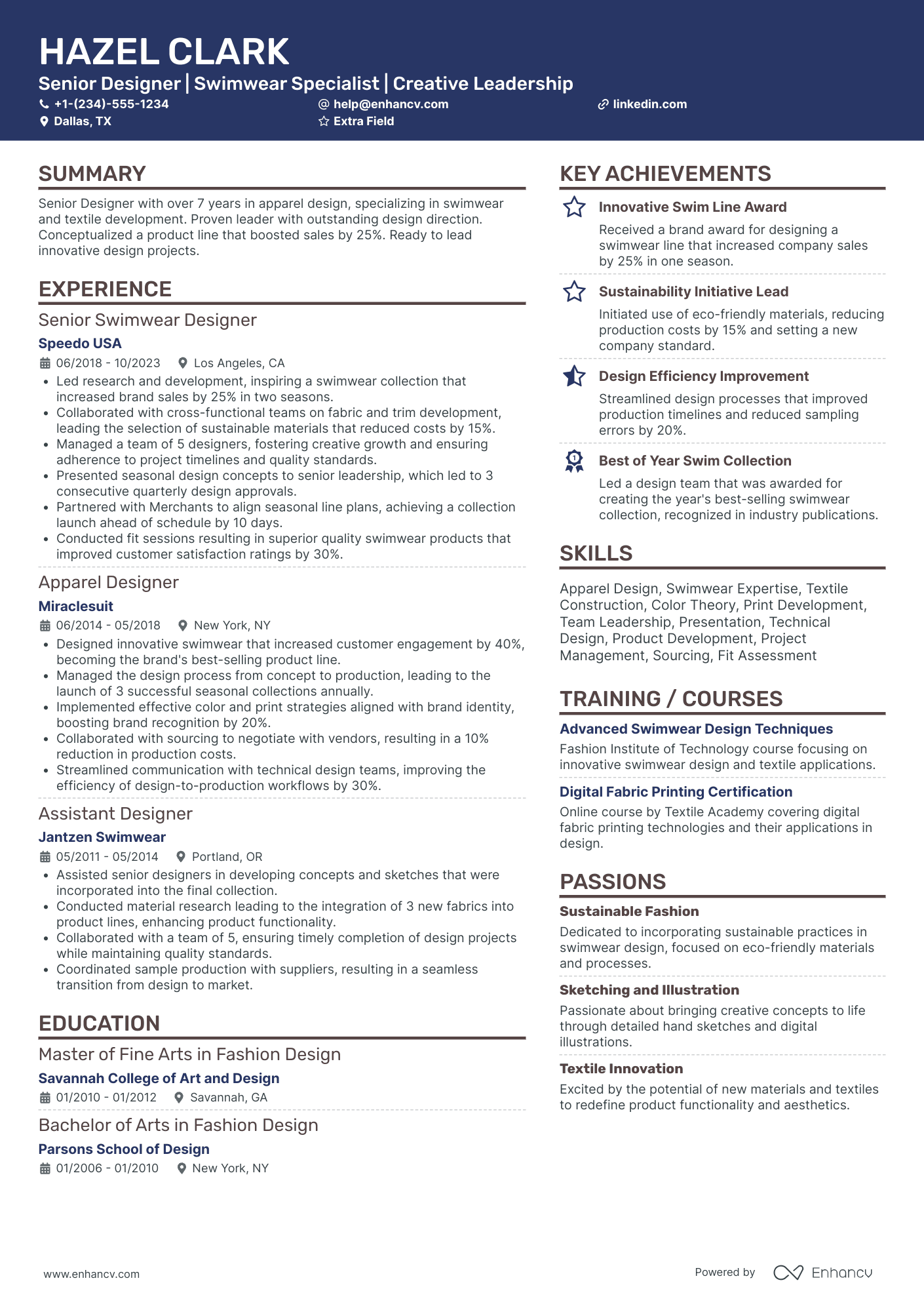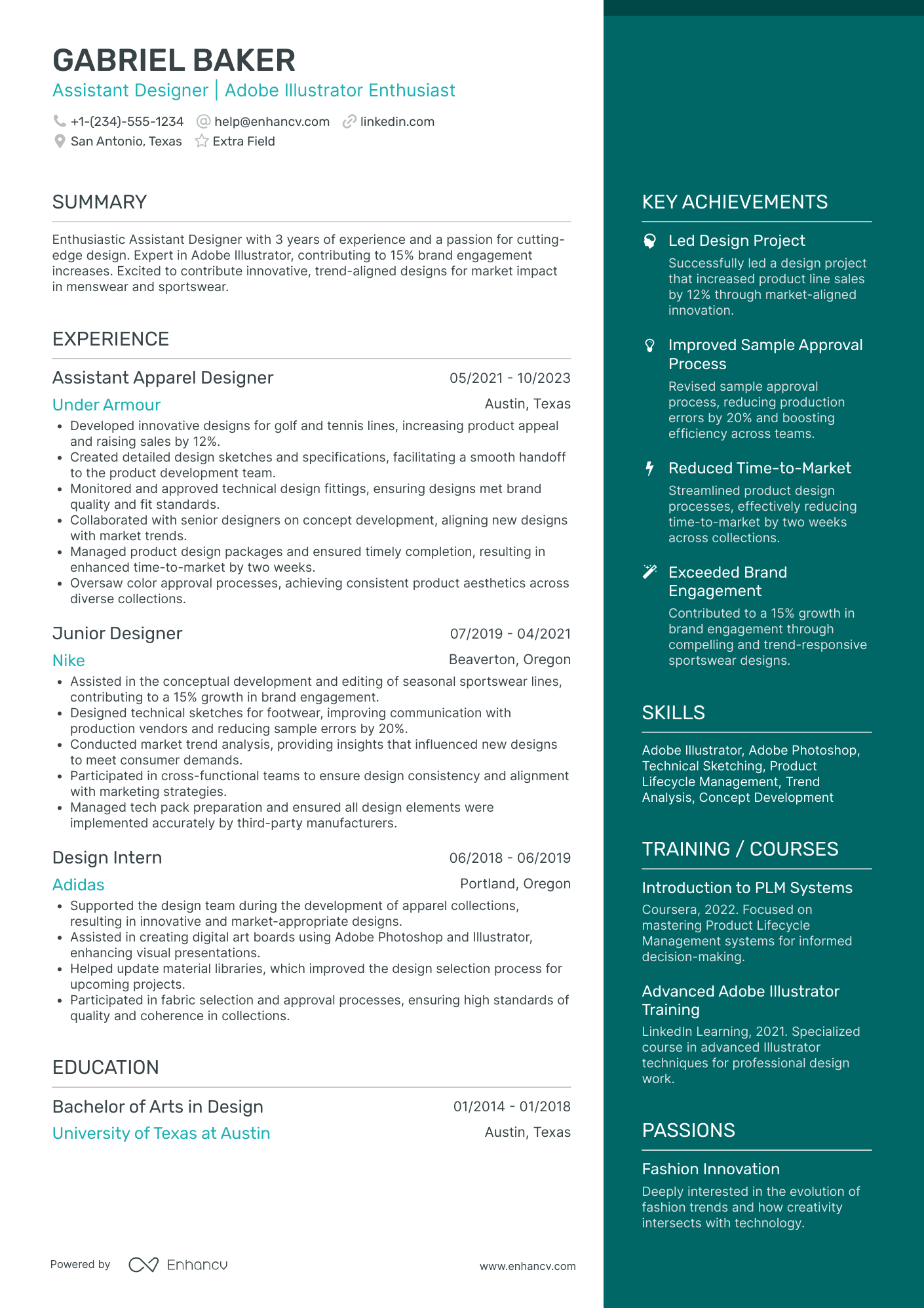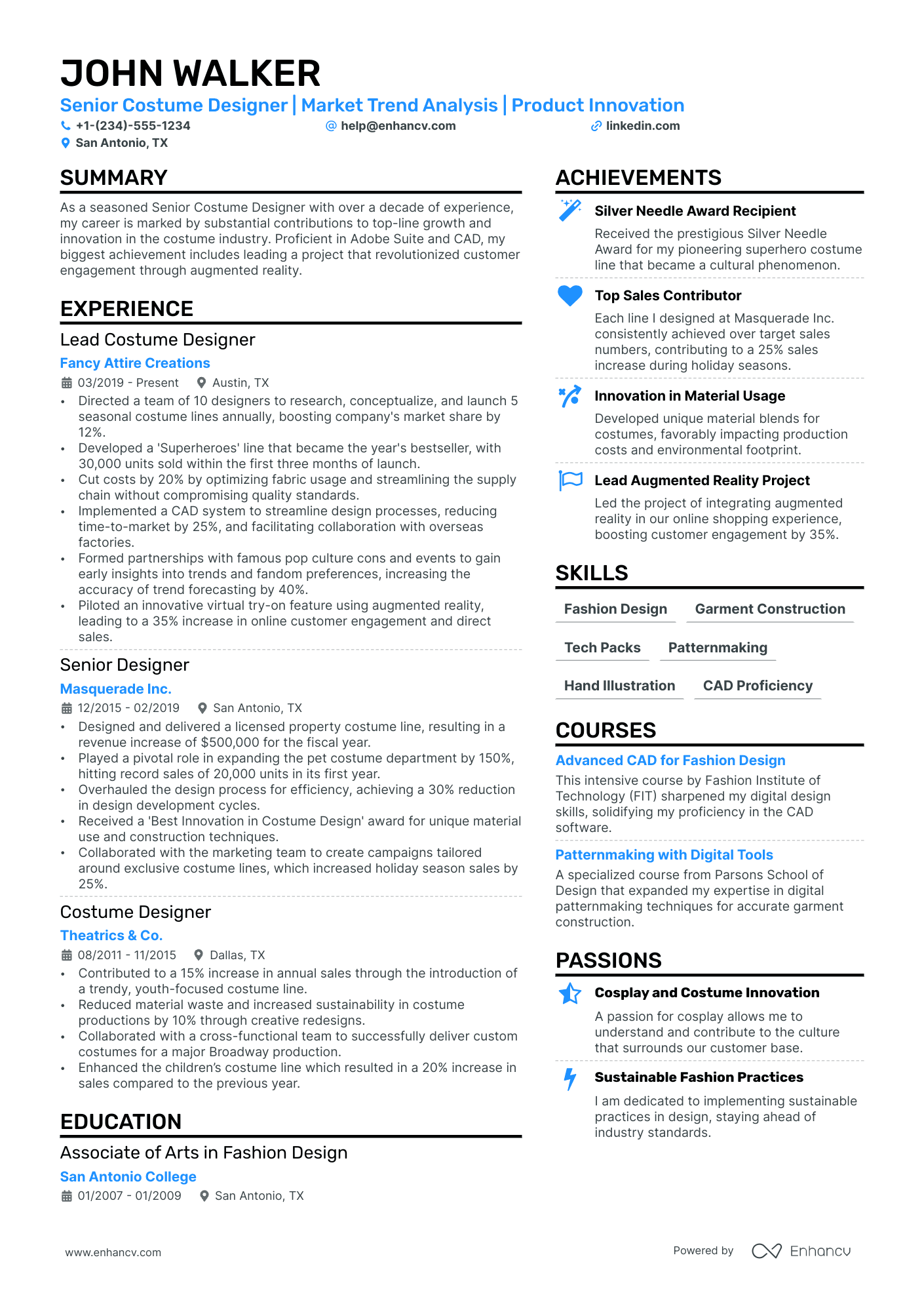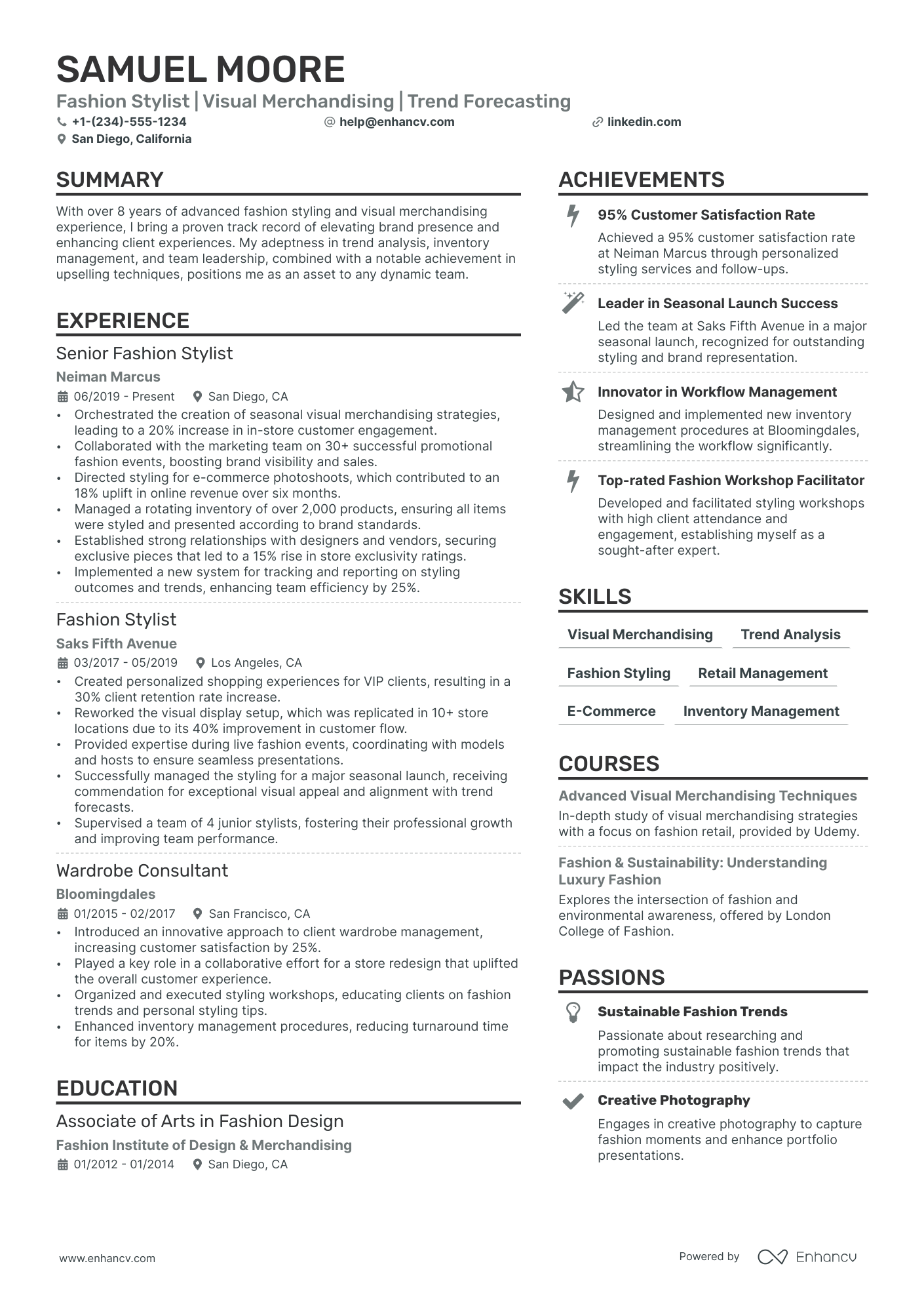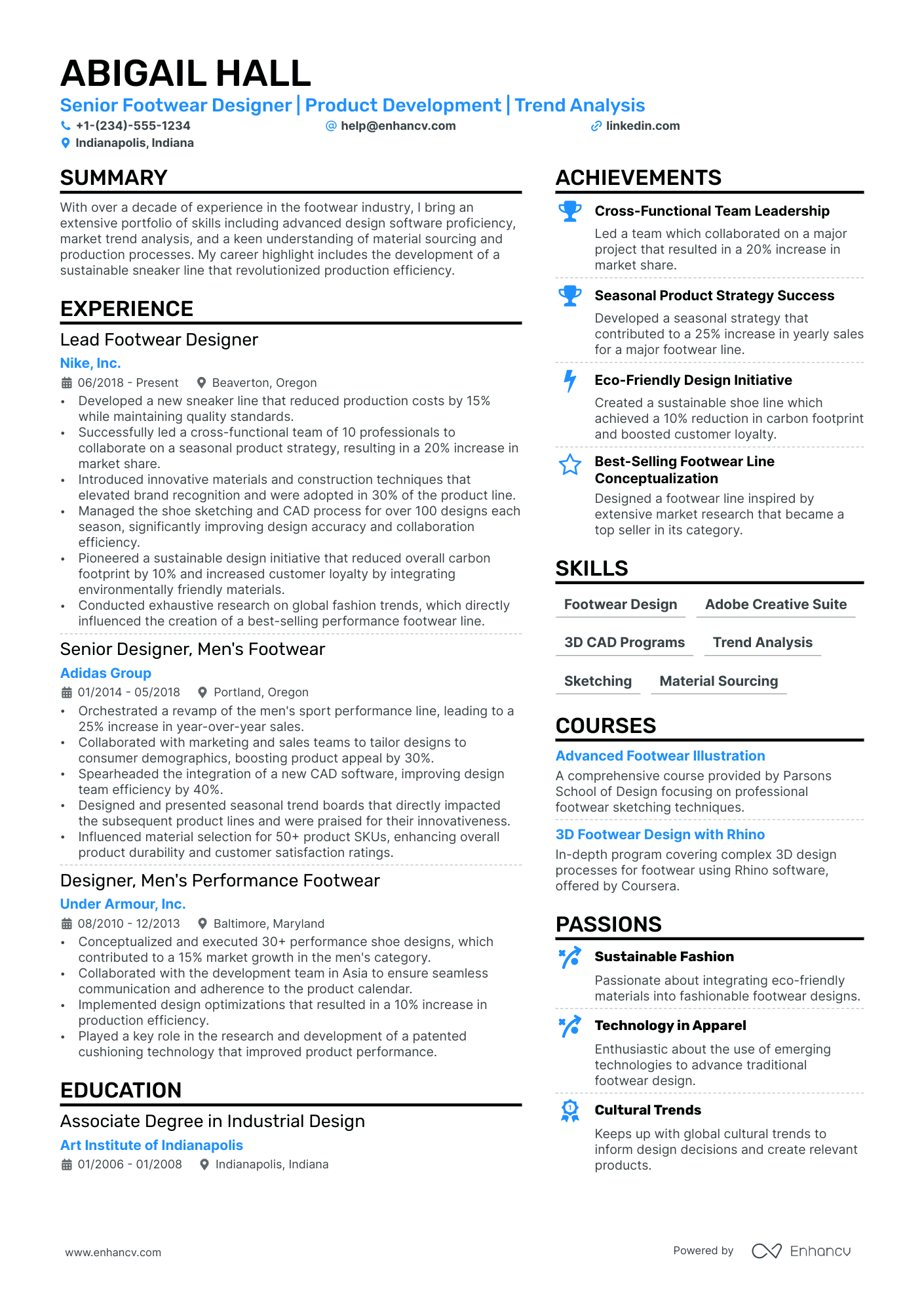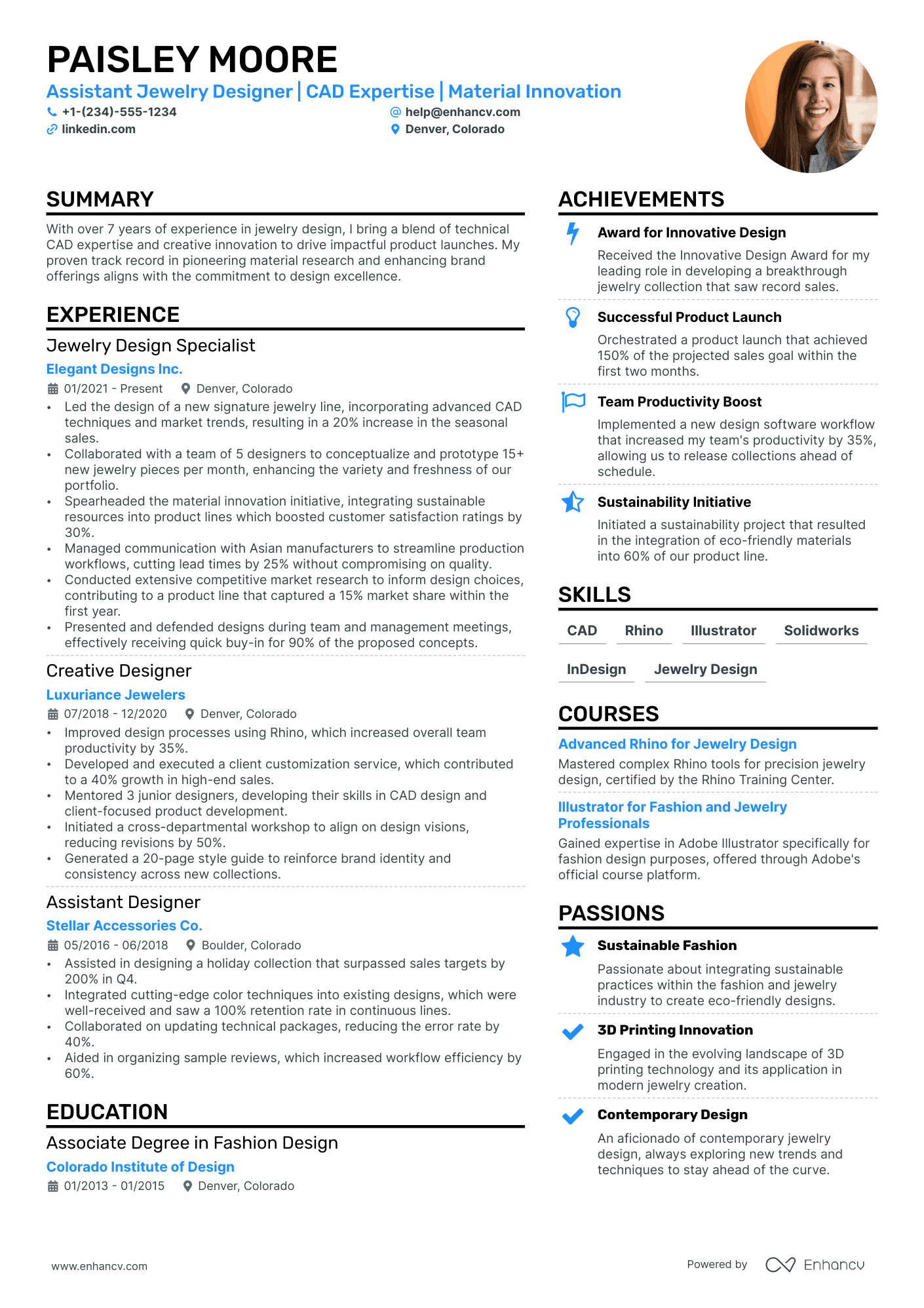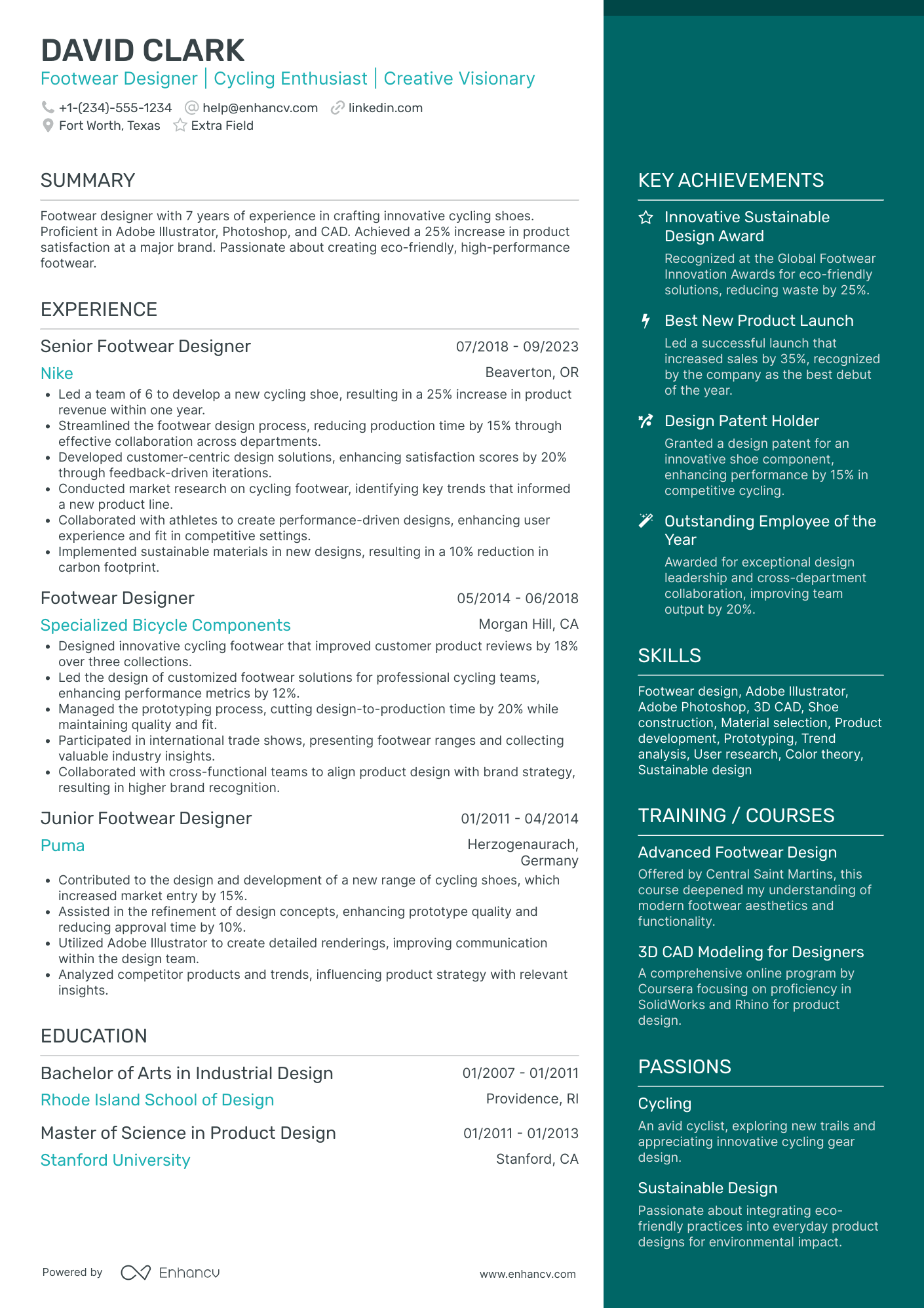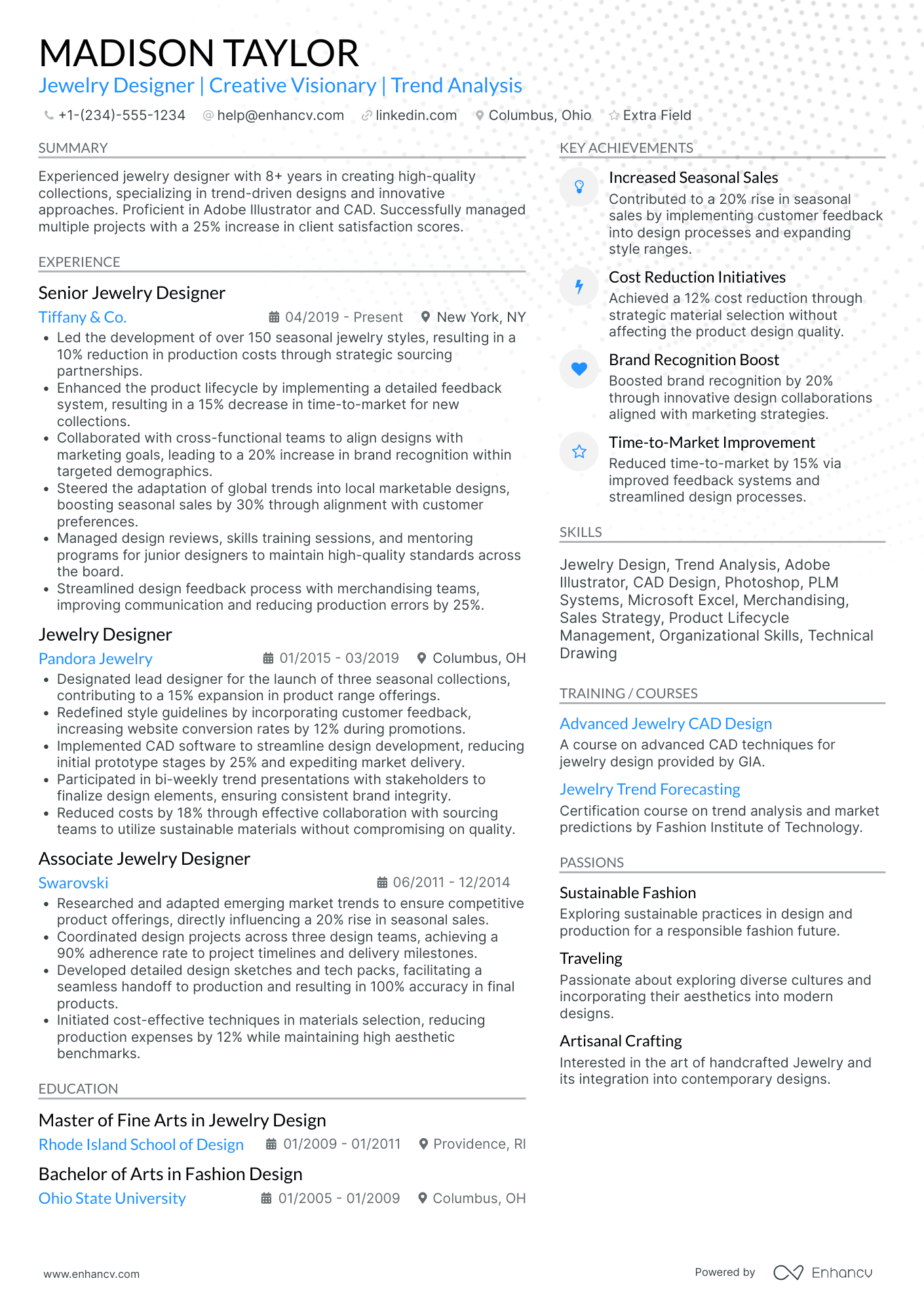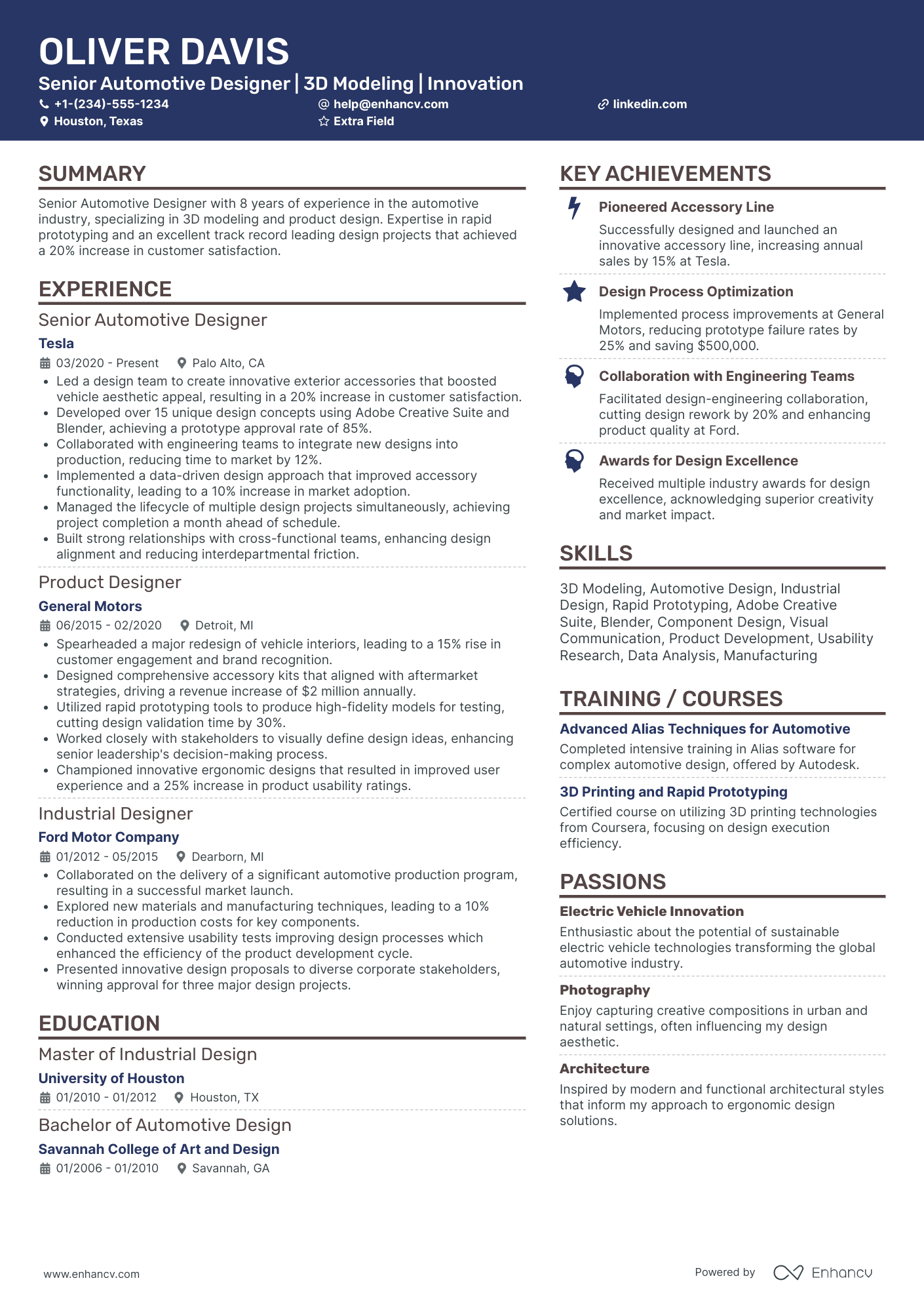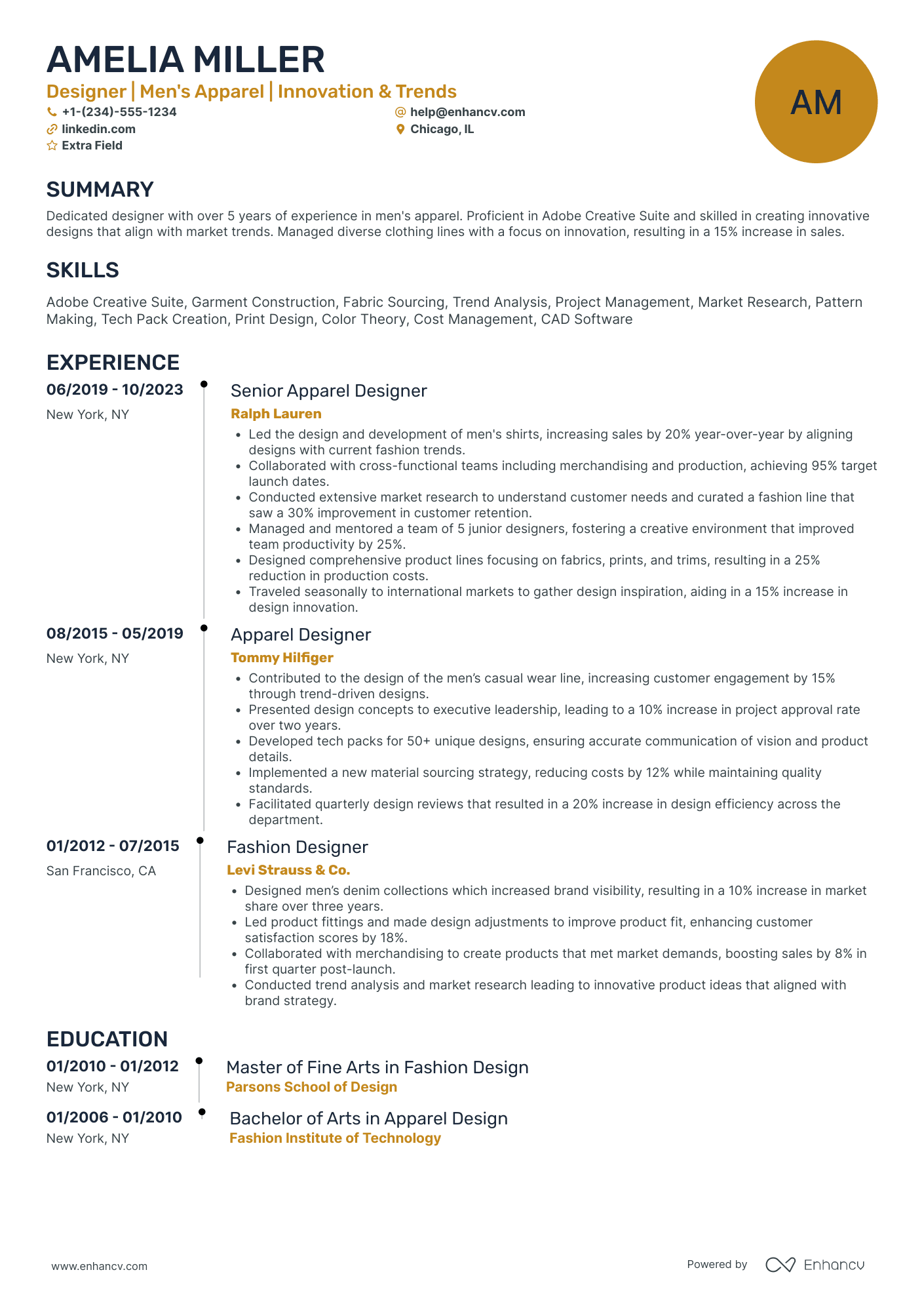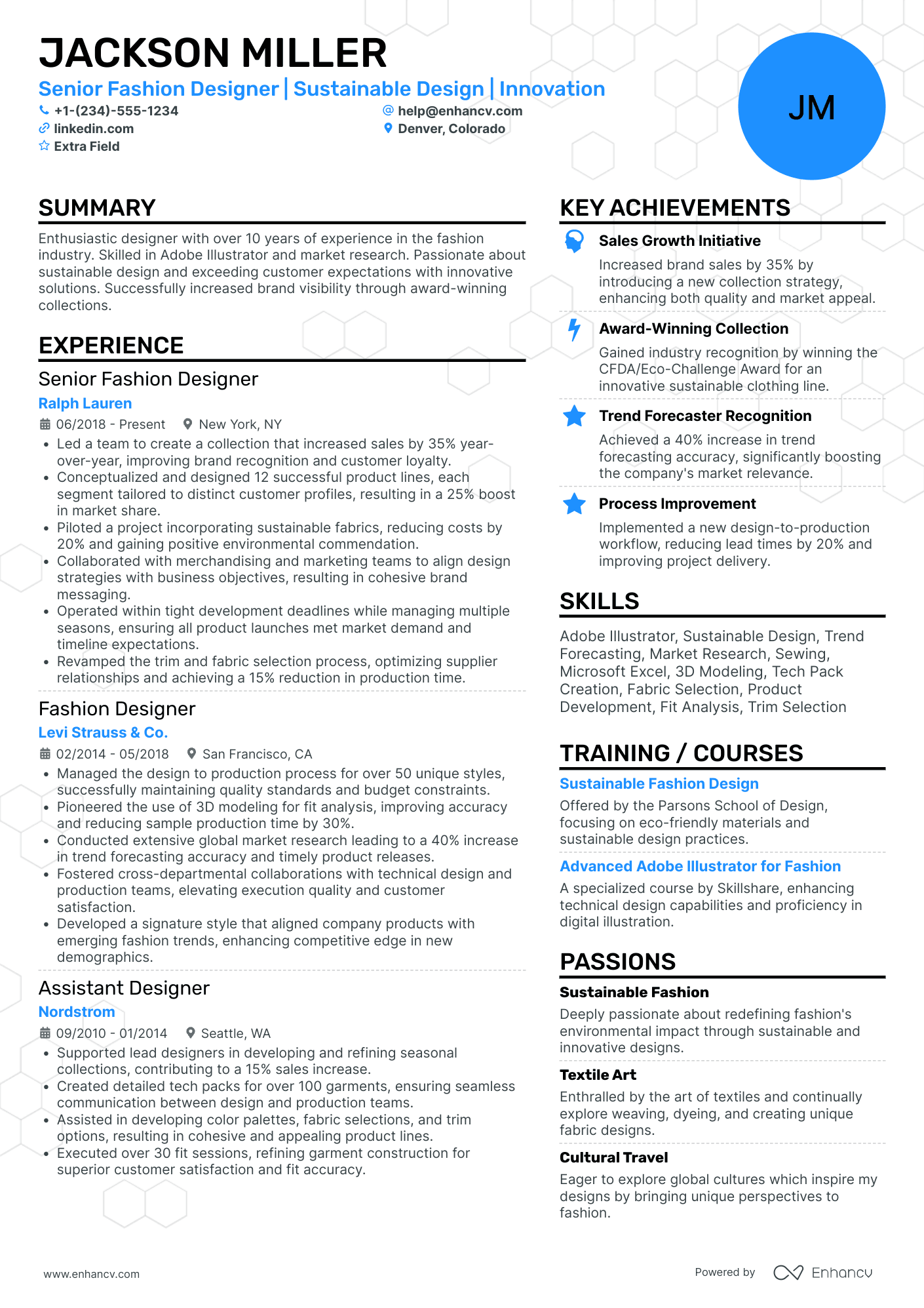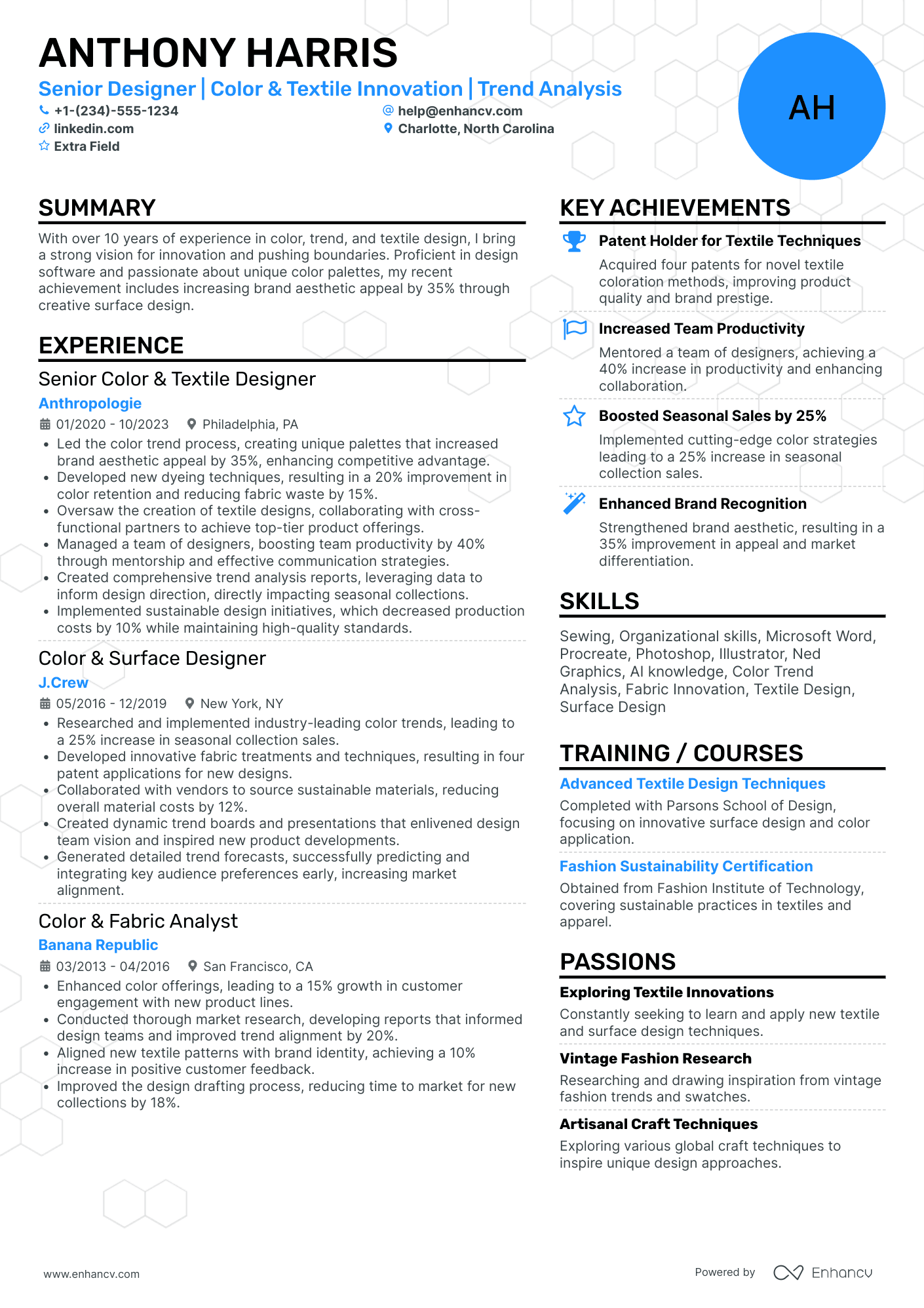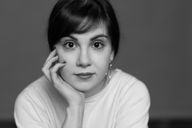A fashion designer’s portfolio might get someone to notice you—but your resume is what convinces them to hire you. Don’t just rely on your designs; show the practical skills hiring managers value.
Your resume should prove you can manage deadlines, work with suppliers, and take collections from sketch to showroom without missing a beat. Pair that substance with a sleek layout, and you’ll impress every recruiter.
At Enhancv, we’ve helped thousands of fashion designers craft resumes that do more than appear creative—they highlight real impact that leads to interviews.
Our guide offers 14 fashion designer resume examples and templates, plus a breakdown of all the essential sections, what works, and what to avoid. All advice is brought to you by Certified Professional Résumé Writers.
Key takeaways
- A fashion designer resume should highlight both creativity and professional reliability.
- Use a hybrid resume format to balance design skills with work experience.
- Always include a portfolio link—it’s essential for a fashion designer role.
- Tailor your bullets by including specific tools, collections, and outcomes that match the job description.
- Quantify your work—yes, it’s possible, even for creatives—by showing sales growth, press features, or production efficiency.
- For entry-level designers, emphasize coursework, projects, and certifications.
- Use our AI Resume Builder to make sure your resume is ATS-friendly, and get thoughtful suggestions at each step.
Fashion Designer resume examples
By Experience
By Role
How to choose the best resume format for a fashion designer
Fashion designers often rely on portfolios and recommendations, but a resume is still needed to show the skills beyond your creativity. Think meeting deadlines, collaborating with teams, and working through the full design-to-production cycle.
The right format will highlight what you’ve achieved so far in a meaningful way.
Which resume format should a fashion designer use?
We usually recommend the reverse-chronological format, as it works for all types of roles.
If you want to give more power to your skills, though, use the hybrid resume format—a chance to give equal weight to your creative skills and your professional experience.
Exception:
If you’re just starting out and don’t have a substantial work history, the functional format will prioritize your skills instead.
What sections should go on a fashion designer resume?
Recruiters expect to quickly spot both creative and professional strengths on a fashion designer resume that make you a reliable hire. Most fashion designer resumes should include these sections:
- Header (contact info)
- Resume summary
- Work experience
- Education and Certifications
- Skills
For a reverse-chronological format, follow the order above.
For a hybrid resume, order your experience section using skills, and below, give examples of using those skills in a work context.
For example:
Creative Direction & Design
Gucci | Assistant Designer | 2021–Present
- Assisted in developing seasonal collections, contributing design concepts that were featured in the Fall/Winter 2022 runway show.
- Researched emerging fashion trends and fabrics to support the Creative Director’s vision.
- Collaborated with patternmakers and seamstresses to bring prototypes from sketch to sample.
Trend Analysis & Product Development
Zara (Inditex) | Junior Designer | 2018–2021
- Designed capsule collections that aligned with fast-fashion trends, resulting in increased sell-through rates by 15%.
- Partnered with sourcing teams to ensure cost-effective material choices without sacrificing quality.
- Created technical sketches and spec sheets for production teams across Europe and Asia.
Brand Identity & Visual Storytelling
H&M | Design Intern | 2017–2018
- Supported senior designers in the development of sustainable fashion pieces as part of the “Conscious Collection.”
- Assisted in mood board creation and design presentations for cross-functional teams.
- Contributed design ideas that were selected for the Summer 2018 global campaign.
Additionally, you can include a projects or an achievements section to give more prominence to concrete examples of your work. Another option would be adding a languages section, especially if you work for global brands.
Our AI Resume Builder is so versatile, it can tend to all kinds of work situations and scenarios.
For entry-level designers or those shifting into fashion from another field, moving Skills or Certifications higher can help show your technical abilities and tools knowledge, taking away the focus from your lack of extensive experience.
Rely on theF-shape scanning pattern when structuring your content. Recruiters’ eyes usually move across the top of the page first, to take in your name, title, and contact info, and then scan down the left side to catch section headings, company names, and dates.
If you’re using a two-column layout, place shorter sections like Skills, Education, or your Portfolio link in the narrower column while keeping the overall order easy to follow left to right. Enhancv’s resume templates include creative options which balance readability with a personal touch.
Want to get your resume score? Run it through Enhancv’s Resume Checker—it analyzes formatting, keywords, and section order, then shows you exactly what to improve.
Is your resume good enough?
Drop your resume here or choose a file. PDF & DOCX only. Max 2MB file size.
How to write your fashion designer resume experience
Your work experience can show hiring managers how you take a design from concept to runway or retail. They’d like to see the collections you worked on, the impact of your designs, and how you contributed to a brand’s success.
Here’s what to include in your experience section:
- Job title and company name: Be clear if you were an Assistant Designer, a Fashion Designer, or a Creative Director, since each signals a different level of responsibility.
- Dates of employment: Keep formatting consistent so your career timeline is easy to follow.
- Location: City and state/country. If you work remotely, you can simply state “Remote.”
Each entry should include three to six bullets including:
- Project scope: Seasonal collections, product categories, market segment.
- Tools and skills: Мention the most prominent, such as: Adobe Illustrator, Photoshop, CAD software, draping, pattern-making, textiles. The rest can be included in your skills section.
- Collaboration: Work with merchandisers, suppliers, pattern makers, photographers, marketing teams.
- Results: Collections featured at shows, boosted sales, reduced costs, faster production, better fabric use.
Here’s an example:
Good example of a fashion designer experience section
Senior Fashion Designer
GlobalTech Solutions — Boston, MA
Jan 2021 – Jun 2024
- Directed a $25M digital transformation program across 5 business units, completing delivery 10% under budget while meeting all compliance standards.
- Guided a cross-functional team of 22 through Agile sprints, achieving a 97% sprint completion rate and reducing release cycle time from 8 weeks to 5.
- Negotiated vendor contracts worth $12M, cutting annual operational costs by 15% while improving service quality through tighter SLAs.
- Designed and launched four seasonal womenswear collections (150+ pieces total), driving a 20% year-over-year increase in retail sales.
- Introduced sustainable sourcing practices that cut fabric waste by 18% while meeting eco-certification standards.
- Collaborated with marketing to align collection launches with brand campaigns, resulting in coverage in Vogue and Elle.
How to tailor your fashion designer resume experience
As a designer, you know the power of a perfect fit. The same applies to your resume—the more precisely it’s tailored to the company’s needs, the stronger and sharper the impression you’ll leave.
Here are several ways to tailor your fashion designer experience section:
- Highlight the type of design work the role emphasizes (ready-to-wear, couture, accessories, kidswear, or sustainable lines).
- Reference the keywords mentioned in the job posting. These could be creative tools or software, like Adobe Illustrator, Photoshop, CLO3D, and CAD programs.
- Point out experience with similar collection sizes, product ranges, or market segments.
- Call attention to collaboration that mirrors the company’s setup—for instance, working with sourcing teams, manufacturers, or marketing departments.
- Back up your work with numbers the brand values most, such as sales growth, production speed, cost savings, or press coverage.
Customizing your resume this way is one of the surest ways to stand out. It transforms a generic list of duties into evidence that you already speak the company’s language and can deliver exactly what they need.
Resume tailoring examples for fashion designers
| Job Description Excerpt | Untailored Bullet | Tailored Bullet | Why This Works |
|---|---|---|---|
| Experience creating seasonal collections using Adobe Illustrator and CLO3D, with focus on sustainable fabrics. | Designed women’s clothing for seasonal lines. | Created 3 seasonal womenswear collections (40+ pieces each) using Adobe Illustrator and CLO3D, incorporating 60% sustainable fabrics. | Uses JD tools (“Illustrator,” “CLO3D”), matches focus on sustainability, and quantifies scope. |
| Proven ability to collaborate with suppliers and manufacturers to meet production deadlines. | Worked with suppliers to develop samples. | Partnered with 5 international suppliers to deliver samples 2 weeks ahead of schedule, ensuring on-time launch for Spring/Summer line. | Shows collaboration, quantifies number of suppliers, and highlights deadline success. |
| Strong background in trend research, fabric sourcing, and ensuring commercial viability of designs. | Researched trends and fabrics for new designs. | Researched market trends and sourced 12 new fabrics that cut material costs by 18% while aligning with the brand's commercial direction. | Ties directly to JD focus (trends, fabrics), quantifies results, and demonstrates business impact. |
When you tailor your resume, you’re not just doing it for the ATS software. Even after machine screening, your document will always be reviewed by a recruiter.
PRO TIP
The simple truth about ATS
We’ve done the research—and no, ATS doesn’t automatically reject your resume. What matters is clarity. Use simple fonts, consistent dates, standard section titles, and the right keywords from the job description. Keep the design sleek but scannable, and you’ll clear both the software and the recruiter’s eye test.
Don’t worry: you don’t need to rewrite your resume for each role. Instead, use Enhancv’sOne-Click Tailoring Tool—paste the job description, and you’ll get bullet points, skills, achievements, and even a summary that target the job posting.
How to quantify your experience on a fashion designer resume
Creative roles don’t exclude measuring your impact. In fact, numbers bring clarity to the scope of your work. Include how many pieces you designed in a collection, the percentage of sustainable fabrics you introduced, or the sales increase from a best-selling item.
Most artistic achievements can be seen through their measurable visible value—don’t miss this opportunity to show you’re a creative force who can also drive results.
Examples of how to quantify fashion designer achievements on your resume
| How to quantify | Example bullet point |
|---|---|
| Show how much revenue or savings your designs contributed to | Designed a capsule collection that increased seasonal sales by 22% and generated $1.2M in revenue. |
| Highlight the percentage of collections or pieces delivered on schedule | Completed 95% of design projects ahead of sampling deadlines, enabling on-time collection launches. |
| Point out the reduction in costs through smarter sourcing or design choices | Sourced alternative fabrics that reduced production costs by 18% without sacrificing quality. |
| Mention recognition or visibility your work achieved | Showcased designs at Paris Fashion Week, gaining coverage in Elle and Vogue. |
| State how your process improvements sped up production | Streamlined pattern revisions, cutting sample turnaround time from 4 weeks to 2. |
How to list your hard and soft skills on your fashion designer resume
Hiring managers want to know if you have both the technical design expertise to create collections and the interpersonal skills to collaborate across teams. Your skills section should be prominently featured in your fashion designer resume.
Our general advice is to place your hard skills in a separate section, and give context to your soft skills through your summary and bullet points in work experience.
Best hard skills for your fashion designer resume
- Adobe Illustrator & Photoshop
- CAD software (CLO3D, Gerber, Lectra)
- Draping & pattern-making
- Fabric knowledge & textile selection
- Trend forecasting & market research
- Garment construction techniques
- Sustainable design practices
- Technical drawing & spec sheets
Best soft skills for your fashion designer resume
- Creativity & innovation
- Collaboration with cross-functional teams
- Time management under tight deadlines
- Attention to detail
- Communication with suppliers & manufacturers
- Adaptability to shifting trends
- Problem-solving during production challenges
- Client and stakeholder presentation skills
Example of weaving soft skills into your experience or summary
- Summary:Innovative fashion designer with 5+ years’ experience creating womenswear collections. Known for blending strong creative vision with cross-team collaboration, delivering designs that boosted seasonal sales by 20%.
- Experience bullet:Led a team of 3 assistant designers and coordinated with suppliers across 4 countries to launch a 30-piece collection on schedule, demonstrating both leadership and communication skills.
How to list your certifications and education on your fashion designer resume
Your education and certifications give recruiters a quick snapshot of the foundation behind your creativity. It’s not about bragging or name-dropping. Formal training, sharpening your technical expertise, and staying aligned with industry trends shows discipline and adaptability.
And also, in a fast-moving industry like fashion, keeping your knowledge fresh through new certifications and training is just as important as your degree.
What to include in an education resume entry:
- Degree and major
- Name of the university or design school
- Location
- Graduation year (skip the month)
- Relevant coursework, awards, or honors (useful if you’re early in your career or switching fields)
In your certification resume section, make sure to add:
- The exact title of the certification
- The organization that issued it
- Year earned (plus expiry date, if it’s close)
Example of an education or certifications section for a fashion designer
Education
- Bachelor of Fine Arts in Fashion Design, 2019
- Parsons School of Design — New York, NY
Certifications
- Adobe Certified Professional in Illustrator, 2022
- CLO 3D Fashion Design Certification, 2021
Best certifications for your fashion designer resume
If you’re just starting out or changing careers:
- Adobe Certified Professional (Illustrator, Photoshop) — demonstrates digital design fluency
- CLO 3D Fashion Design Certification — highlights 3D and CAD skills in demand today
- Textile Design Certificate (offered by FIT, Coursera, or Udemy) — solid grounding in fabrics and materials
- Fashion Marketing or Merchandising Certificate — shows awareness of the business side of fashion
For designers with mid-level experience:
- Advanced Draping or Patternmaking Certification (FIT, London College of Fashion)
- Sustainable Fashion Certification (Parsons, UAL)
- CAD/PLM Software Certifications (Gerber, Lectra)
- Apparel Product Development & Sourcing Certification
For specialized roles:
- Luxury Brand Management Certification — ideal for those designing in premium markets
- Sustainable Textiles & Materials Certification — valuable for eco-conscious brands
- Fashion Styling or Visual Merchandising Certification — bridges design and presentation skills
- Digital/Virtual Fashion Certification (covering AR, VR, or metaverse garments)
How to write your fashion designer resume summary
For mid- or senior-level fashion designers, the resume summary is your first chance to prove you can balance creativity with commercial impact. This section is sometimes the only thing HRs will read, so make sure you make it count.
A strong summary should:
- State your current role and years of experience.
- Highlight the types of collections, markets, or brands you’ve worked with.
- Mention key design tools or areas of expertise.
- Include a couple of measurable achievements.
- Emphasize what you bring to the employer—how you respond to their needs.
Example summary
Fashion designer with 8+ years of experience in womenswear and accessories for luxury and ready-to-wear brands. Skilled in Adobe Illustrator, CLO3D, and textile research, bringing collections from concept to market with precision. Collaborative partner to production, marketing, and suppliers, delivering modern, sustainable designs that strengthen brand identity and connect with audiences.
Here’s the formula this sample follows: it shows who you are, what you’ve done, how you did it, and what it achieved—exactly what hiring managers need in just a few lines.
Optimize your resume summary and objective for ATS
Drop your resume here or choose a file.
PDF & DOCX only. Max 2MB file size.
How do I write a fashion designer resume with no experience?
Fashion is one of the few fields where being entry-level can actually be an advantage. Many employers value fresh perspectives, bold ideas, and the energy that new designers bring to the table. Even without formal work experience, you can build a resume that displays your creativity, transferable skills, and academic or personal projects.
What to include in place of work experience:
- Relevant coursework or academic design projects (capsule collections, textile research, portfolio work)
- Internships or part-time fashion-related roles (assistant designer, retail, styling, merchandising)
- Volunteer or extracurricular involvement (fashion shows, competitions, student clubs, event organization)
- Certifications such as Adobe Illustrator, CLO3D, or sustainable fashion training
- Additional sections like “Projects” or “Achievements” to highlight outcomes instead of job titles
Resume format tip for entry-level fashion designers:
A well-crafted cover letter can make up for limited experience by showing your passion for fashion and your unique design perspective. Use it to highlight academic projects, internships, or portfolio pieces that best reflect your skills. Most importantly, connect your creativity and values to the company’s brand identity so the hiring manager can see why you’re a natural fit.
Drop your resume here or choose a file.
PDF & DOCX only. Max 2MB file size.
Frequently asked questions about fashion designer resumes and job applications
Here are a few more questions to cover any extra dilemmas you may have.
What should your fashion designer resume header include?
Your header should give recruiters everything they need to contact you at a glance. Include your full name, phone number, professional email address, city and state, and a link to your online portfolio, GitHub, or LinkedIn.
What does a good fashion designer resume look like?
A strong resume balances style with substance. It should be clean, professional, and easy to scan—think simple fonts, well-spaced sections, and a touch of color only if it enhances readability. For most designers, one page is enough; those with 10+ years of experience or leadership roles may need two. Don’t forget: your resume is just as important as your designer portfolio.
How should I name and format my resume file?
Always save your resume as a PDF to keep the layout intact, unless the job posting asks for another format. Use a clear, professional file name such as Firstname-Lastname-Fashion-Designer-Resume.pdf.
Avoid vague names like resume-final.pdf, which look sloppy and get lost in busy recruiters’ folders.
How do I show career progression on a fashion designer resume?
Employers want to see growth over time. Make promotions or title changes visible in your work history (e.g., Assistant Designer → Designer). Show how your responsibilities expanded—perhaps you moved from supporting a single line to leading entire collections, took on sourcing, or started managing junior designers. Even small steps signal readiness for bigger opportunities.
Do I need industry-specific experience to land a fashion design role?
Not always. While experience at a fashion house is valuable, transferable skills from related fields—like retail, merchandising, or costume design—can also get you in the door. What matters most is tailoring your resume to show you understand the industry’s pace and that your portfolio matches the brand’s aesthetic.
What should I include in a fashion designer cover letter?
Your cover letter allows you to give more context to your achievements. Instead of repeating your resume, explain why you’re drawn to the company’s aesthetic and give one example—from your portfolio, an internship, or a project—that proves you can contribute in the same style.
Keep it personal, focused, and under one page.
How much do fashion designers earn?
Fashion designer salaries vary by location and industry. In the U.S., the median annual pay is around $80,690 (BLS, 2024). Designers in major fashion hubs and in luxury or entertainment sectors often earn more.
Median salary for project managers in the U.S. by state
| State | Mean Annual Salary |
|---|---|
| New Hampshire | $107,140 |
| Vermont | $102,300 |
| Massachusetts | $92,500 |
| New Jersey | $90,820 |
| Washington | $90,350 |
In conclusion
Fashion design is all about vision, but your resume is about connection—it has to show recruiters not only what you can create but also how you can deliver for their brand. With the right format, tailored achievements, and a strong portfolio link, your resume will fit the role as perfectly as a bespoke garment.
